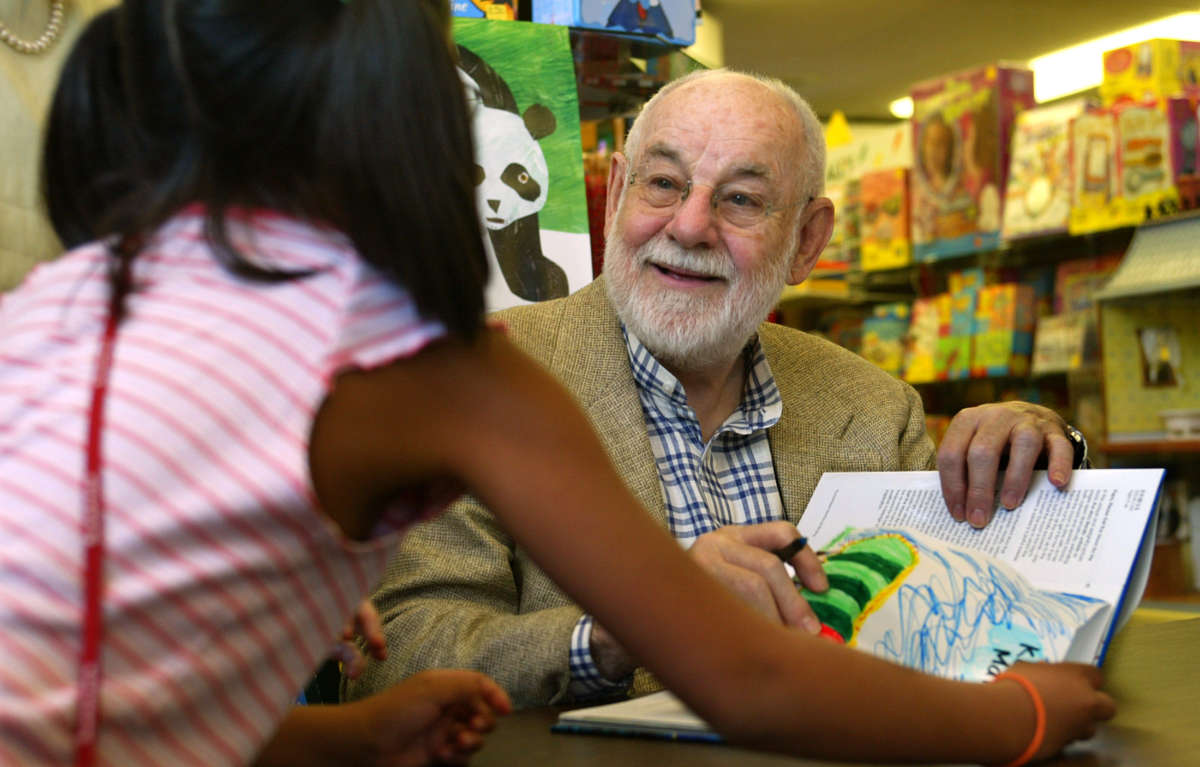The little holes throughout the book, the ones milled through the pictures of food — that’s where your heart goes, carried by tiny questing fingers seeking form, substance, input, delight. The painted art leaps from the page at every turning, 22 lines from beginning to end, a feast by moonlight, and then … a beautiful butterfly!
The passing of Eric Carle, author of more than 70 children’s books in a career that touched six decades, was met with an outpouring of grief and gratitude. His most famous work, The Very Hungry Caterpillar, is 48 words shorter than the Gettysburg Address, but has touched the lives of millions upon millions of children and their parents all over the world since its publication in 1969.
Caterpillar has been translated into 70 languages over the years, and is the first thing your friends hand you when they find out you’re going to have a kid. You need bottles, diapers, blankets, onesies and here, this book, the one with the holes in it, right on top of the pile.
The genius of Caterpillar is its simplicity. By the time they’ve finished the book, the child has practiced counting, learned what certain foods are as they recite the days of the week, sharpened their seeking skills by locating the caterpillar in its various hiding places, reveled in a gorgeous palette of colors, and like as not giggled like a chickadee every time they poked a curious finger through one of the holes. And at the end? A vivid reminder that we all grow and change, and the truth of that is beautiful as well.
That simplicity, however, belies the depths and the darkness Carle confronted in his youth. His family lived in Stuttgart, Germany, under Nazi rule during World War II. His father was drafted, sent to the Russian front, and became a prisoner of war. Carle, only 15, was forced to dig trenches along the Siegfried Line. His home was a bomb-shattered hulk. His father came back from the war weighing 85 pounds, “a broken man,” according to Carle. In 1952, Carle moved to New York City with $40 in his pocket, and became a graphic designer for The New York Times. Not long after, he was drafted into the U.S. Army — and stationed in Germany.
“Though Mr. Carle didn’t speak often about his upbringing in Nazi Germany,” the Times reported upon his passing at age 91, “he did say that his time spent in war zones had deeply influenced his work. The grays, browns and dirty greens used by the Nazis to camouflage the buildings only heightened his love for intense and joyful colors.”
That is the secret magic of Caterpillar. Carle took the horrors of his own childhood, ground them into brilliant pigment, and painted tiny worlds filled with the kind of joy and wonder that only the youngest among us can truly experience. The artwork in Caterpillar, along with his other works, such as Brown Bear, Brown Bear, What Do You See? and The Very Busy Spider, fairly sings from the page with a complexity illuminated by the beatific smile of a grandfather moon.
In the ongoing aftermath of COVID-19, with so much uncertainty still surrounding us, so many questions about what this world will be like after the storm passes — if it ever truly does — Eric Carle and The Very Hungry Caterpillar are highly instructive. All of us face a clouded future today, and many of us have seen things this last year that cannot be unseen. What, then, comes next?
Simplicity: whatever can be done within reach of your arm. Eric Carle took 224 words, 22 lines and his paintbrush, and made the world better. Such a small thing, such an enormous thing, is within the grasp of each and every one of us. Take pain and become joy, take suffering and become learning, take rage and become the kind of love that makes children smile, and if we all do it in our own little way, we all get to come home.
My daughter, now a robust and feisty 8 years old, still asks me to read Caterpillar to her sometimes. Her reading skills have skyrocketed past it, but I am always happy to oblige. As the cover opens, my big girl shrinks into my lap and falls back in time, counting the holes like she used to, pretending to eat the strawberries like she used to, and laughing delightedly at the reward on the final page. Her experience of Carle’s work today — a snuggled return to a safe literary harbor — is almost exactly what it was when I read it to her for the first time, the first book she and I ever read together.
Eric Carle did that within reach of his arm. So can you, I believe. So can we all.
For my daughter.
3 Days Left: All gifts to Truthout now matched!
From now until the end of the year, all donations to Truthout will be matched dollar for dollar up to $38,000! Thanks to a generous supporter, your one-time gift today will be matched immediately. As well, your monthly donation will be matched for the whole first year, doubling your impact.
We have just 3 days left to raise $38,000 and receive the full match.
This matching gift comes at a critical time. As Trump attempts to silence dissenting voices and oppositional nonprofits, reader support is our best defense against the right-wing agenda.
Help Truthout confront Trump’s fascism in 2026, and have your donation matched now!
